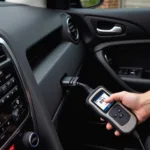The 1996 Ford F150 was a pivotal year for emissions regulations and onboard diagnostics. If you’re wondering, “does a 1996 F150 have OBD2,” the answer is not quite straightforward. Some 1996 F150 trucks have OBD2, while others have the older OBD1 system. This can make things confusing when you’re trying to diagnose a check engine light or perform your own maintenance.
 1996 Ford F150 OBD2 Connector
1996 Ford F150 OBD2 Connector
How to Tell if Your 1996 F150 Has OBD2
To determine if your 1996 F150 is equipped with OBD2, you can use these simple checks:
- Check the Vehicle Emissions Sticker: Open the hood and look for the Vehicle Emissions Control Information (VECI) sticker. It’s usually located on the underside of the hood or on the radiator support. If the sticker states “OBD II Certified,” then your truck has the OBD2 system.
- Look for the Diagnostic Connector: The OBD2 connector is typically located under the dashboard on the driver’s side. It’s a trapezoidal 16-pin connector. OBD1 connectors are often rectangular and may have a different number of pins.
- Use a VIN Decoder: You can input your truck’s Vehicle Identification Number (VIN) on a VIN decoder website or app. This will provide detailed information about your F150, including the specific emissions system it uses.
Why Does It Matter if My 1996 F150 Has OBD2?
The introduction of OBD2 in 1996 brought significant changes to how vehicles monitor and report emissions-related issues:
- Standardized Diagnostics: OBD2 uses a standardized connector and communication protocol, making it easier for mechanics and vehicle owners to access diagnostic information.
- Enhanced Monitoring: OBD2 systems monitor a wider range of engine and emissions components, providing more comprehensive diagnostic capabilities.
- Emissions Readiness: OBD2 includes an emissions readiness check, ensuring that your truck’s emissions control systems are functioning properly.
What if My 1996 F150 Doesn’t Have OBD2?
If your 1996 F150 has the older OBD1 system, it’s important to note that:
- OBD1 scanners are less common: You might have a harder time finding a scanner that can read OBD1 codes.
- Diagnostic procedures can be more complex: Troubleshooting engine problems might require manufacturer-specific information and tools.
In Conclusion
Knowing whether your 1996 F150 has OBD2 or OBD1 is essential for accurate diagnostics and repairs. If you’re unsure, checking the VECI sticker or using a VIN decoder can provide a definitive answer. Whether your truck has the older OBD1 or the more modern OBD2, understanding its capabilities is crucial for maintaining its performance and addressing any engine-related issues effectively.
FAQs
Q: Can I upgrade my 1996 F150 from OBD1 to OBD2?
A: Upgrading an OBD1 vehicle to OBD2 is not a simple plug-and-play process. It typically involves extensive modifications to the engine control unit (ECU), wiring harness, and sensors, and is often not cost-effective.
Q: Where can I find an OBD1 scanner for my 1996 F150?
A: You can often find OBD1 scanners online or at auto parts stores specializing in older vehicles. Make sure to choose a scanner that is compatible with Ford vehicles.
Q: My check engine light is on in my 1996 F150. What should I do?
A: If your check engine light is on, it’s crucial to have the diagnostic trouble codes (DTCs) read as soon as possible. This will help pinpoint the potential issue and guide repairs.
Q: Can I use an OBD2 scanner on my 1996 F150 if it has OBD1?
A: No, OBD2 scanners are not backward compatible with OBD1 systems. Using an incorrect scanner can lead to inaccurate readings or even damage to your vehicle’s computer.
obd2 connector diagram 2012 nissan altima
Need more help? Contact us on WhatsApp: +1(641)206-8880, or email us at [email protected]. We have a 24/7 customer support team ready to assist you.

